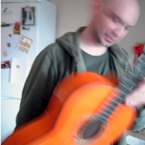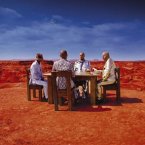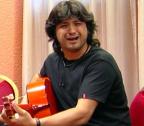Welcome to one of the most active flamenco sites on the Internet. Guests can read most posts but if you want to participate click here to register.
This site is dedicated to the memory of Paco de Lucía, Ron Mitchell, Guy Williams, Linda Elvira, Philip John Lee, Craig Eros, Ben Woods, David Serva and Tom Blackshear who went ahead of us.
We receive 12,200 visitors a month from 200 countries and 1.7 million page impressions a year. To advertise on this site please contact us.
|

|
|
sticking points for speed
|
You are logged in as Guest
|
|
Users viewing this topic: none
|
|
Login  | |
|

   
Miguel de Maria
Posts: 3532
Joined: Oct. 20 2003
From: Phoenix, AZ

|
 sticking points for speed sticking points for speed
|
|
|
I have been getting frustrated with my scales lately because of inconsistency. Sometimes with picado, even the easy things seem hard. I didn't use m at all last year, and now I've finally gotten it so that it is strong again. But it seems like I've lost quite a bit of top-end speed, as well as useable speed.
Anyway, what I normally do is warmup and play scales at 80 bpm (sixteenths) for quite awhile, and eventually crank it up to 120. So 80 is the slow, and 120 is the fast. I would get frustrated because the 120 would give me problems.
Today, after getting annoyed I tried to crank it up to 135 and did the scales without any problem! I couldn't get it together on 120, but 135 was fine. I thought that I had lost a lot of speed but it was a bit of an illusion.
That reminds me sticking points. Basically in picado you have gears, or motions, kind of the difference between walking and running. (maybe Grisha also has a Superman gear). That's why most people can play their scales in a certain range of speeds fine, and then they hit the wall. A lot of times they think that means they've reached their limit, but all it means is they've reached their _speedwalking_ limit. They have to find their 2nd gear and then there is a whole new speed limit. (and when you reach that, maybe you start using 3 fingers?)
Anyway, it seems that 120 is my walking limit. And by the way, the limits are ugly. There is a spot, let's call it a singularity, where my technique is just a shambles! Scott Tennant talked about this in his book, too.
Disclaimer: I don't recommend blasting away at scales unless you've been playing them slowly and surely with full relaxation for many years. This statement has not been evaluated by the Surgeon General.
_____________________________
Connect with me on Facebook, all the cool kids are doing it.
https://www.facebook.com/migueldemariaZ
Arizona Wedding Music Guitar
|
|
|
|
REPORT THIS POST AS INAPPROPRIATE |
Date Jul. 19 2006 21:40:20
 |
|

   
Jon Boyes
Posts: 1377
Joined: Jul. 10 2003

|
 RE: sticking points for speed (in reply to Miguel de Maria) RE: sticking points for speed (in reply to Miguel de Maria)
|
|
|
quote:
ORIGINAL: Miguel de Maria
I have been getting frustrated with my scales lately
Agree with you on the 'gear' concept, in fact I am sure we had this argument years ago where I was talking abut the walking vs running analogy and you disgreed with me 
Anyway, here's a thought vaguely related to your post Mike - I wonder how many of the great flamencos actually practice scales, as opposed to just practicing the actual runs they need to play in their toque? Scale practice is kind of enshrined in CG pedagogy (as it is in classical music in general, whatever the instrument), but there isn't that 'schooled' pedagogy in flamenco.
The reason I bring this up is because I was talking to Rob MacKillop the other day (Scottish musician/composer who plays lute and various other instruments at an international level - Ron knows him). I was asking him about lute technique (as I had heard many lute players could play blistering runs) how they finger their scales and how the rh mechanism works in lute tech.
Anyway, I was really surprised when Rob said that he didn't know ANY lute players who praticed scales! They just work on the runs they need for their pieces, thats it.
This got me thinking - we tend to focus an awful lot of attention of the mechanism of picado, but very little on the practice habits of the greats, obviously because watching videos doesn't tell us how they practice, yet that is surely going to make some interesting reading.
Hey, is this another fast picado thread? 
_____________________________
Spanish Guitarist in Devon, Cornwall and Somerset
|
|
|
|
REPORT THIS POST AS INAPPROPRIATE |
Date Jul. 20 2006 9:09:28
 |
|

   
seanm
Posts: 169
Joined: Apr. 5 2005
From: Halifax, Nova Scotia

|
 RE: sticking points for speed (in reply to Miguel de Maria) RE: sticking points for speed (in reply to Miguel de Maria)
|
|
|
I had a lesson with an player residing in Spain recently (a classical teacher who teaches at an academy in Spain and interacts with a lot of flamencos). She showed me two exercises that she had me do a couple of time during my lesson and then said "now try your scale" OMG. What a difference. Here they are. I HIGHLY recommend these if you don't already do them.
1) Backward rasqueados scales for finger return strength
Play a basica scale in first position but play it slooooowwwwly using the back of your nails like ras. downstokes (do NOT lock the fingers into the thumb for this one ... so use rasqueados 'free stroke' .. did I just coin that term ;) ) alternating all combinations in odd groupings (so for two fingers do triplets, for three fingers do sixteeths). For instance, I M I (on note one of the scale), M I M (on note two), etc up and back. Very controlled, even, loud and well accented triplets. If your forearm does not burn after 30 seconds you don't need the exercise, or you aren't doing it right. Do this for M A M, A M A and A M I A, M I A M, I A M I, etc. Be carefully not to hurt yourself, seriously. You should find that after a minute of that your fingers are drawn back to the strings like magnets when you play scales.
2) Extreme slow scales with extremely dotted rhytms. I always played my dotted scales when practicing too much like a simple dotted scale. She suggested something like a quadruple dotted whole note and a 64th. This forces you to think before the next 2 note sequence and allows you to relax between them. Also, do it with the first of the two notes being the fast one (so the reverse of the above).
These have improved my scales 10 times almost immediately because my fingers where fast ... but just not co-ordinated.
Sean
|
|
|
|
REPORT THIS POST AS INAPPROPRIATE |
Date Jul. 20 2006 14:20:06
 |
|

   
Miguel de Maria
Posts: 3532
Joined: Oct. 20 2003
From: Phoenix, AZ

|
 RE: sticking points for speed (in reply to Miguel de Maria) RE: sticking points for speed (in reply to Miguel de Maria)
|
|
|
Jon,
I don't recall disagreeing with you, I think the point was you said you can't practice the 2nd gear. I remember that I and also gerundino disagreed. You said practicing walking doesn't help running, but as gerundino pointed out, practicing running slow does. Aha! Take that! :)
As far as scales, I'll have to admit that I'm actually talking about scalar flamenco runs. Things like those pesky runs in Sabicas' Soleares and Panaderos Flamencos, etc.
However, I do also practice scales around the fingerboard at times, adn from CG etudes such as Aguado and Sor. Also, I think practicing ascending scales is very important. You'll feel a strange floating feeling above the sixth strings that I think it's important to become familiar with. It seems to me that it helps balance and overall mobility, too. And as HEnrik said, you can't really know the fingerboard without having traversed it up and down many times.
I would be surprised to hear Vicente, PDL and Tomatito did not practice scale shapes in every conceivable form. I don't buy the "ignorant genius" thesis.
It's funny how useless picado is in general, but how important a lot of us take it. I have to be honest, it's my favorite technique. Once I can rip fast picados at will, I think part of me wil rest easy and have that self satisfaction! IT's just such a long journey. Once I can play as well as Grisha at 9 years, I know I will have hit the big time. :)
_____________________________
Connect with me on Facebook, all the cool kids are doing it.
https://www.facebook.com/migueldemariaZ
Arizona Wedding Music Guitar
|
|
|
|
REPORT THIS POST AS INAPPROPRIATE |
Date Jul. 20 2006 14:42:41
 |
|

   
seanm
Posts: 169
Joined: Apr. 5 2005
From: Halifax, Nova Scotia

|
 RE: sticking points for speed (in reply to Miguel de Maria) RE: sticking points for speed (in reply to Miguel de Maria)
|
|
|
Hey,
I was looking up "quadruple dotted" to make sure I wasn't insane (did my degree was years ago :) ) and found this right away. It explains the exercise much better than I (BTW, it is from a clarinet forum who have finger coordination issues of their own to deal with)
quote:
How to Smooth Out the Fast Passages
The problem you are having with the fast passages is that sometimes moving from one note to the next involves just 1 finger (say, low C to low D), and sometimes it involves many fingers in contrary motion (as in going over the break). The more complex movements tend to take more time, and it's also hard to keep them as clean as the easy ones.
Therefore, you need to single out the hard finger movements and clean them up. As you have found, you do *not* achieve this by just running through a passage over and over. The following method isolates each interval and lets you work on it individually.
Beginning *very* slowly, play the passage in pairs of quadruple-dotted 16ths and 128ths, repeating each pair until you have it clean and snappy. At the beginning, play just the first note; stop and take a small breath; then "snap" from the second to the third notes as quickly as possible, repeating until it is clean; stop and take a small breath; then "snap" from the 4th to the 5th note, and so on. Then leave out the breaths and work up gradually to close to performance tempo. Notice that you are working on the transition between notes 2 and 3, then 4 and 5 and so on.
Then begin again with a 128th followed by a quadruple-dotted 16th. This isolates the transitions you skipped, between notes 1 and 2, 3 and 4, and so on.
Work up both versions slurred and tongued.
When you finish, you will have isolated and cleaned up the transition between each note and the next. Then, go back to straight 16ths, which will be almost magically smooth.
(A tough but effective way to perfect your technique is to work this exercise through all the scales, chords and other patterns in Part 3 of the Baermann method. It's a big mountain to climb, but all professionals have done it.)
Sean
|
|
|
|
REPORT THIS POST AS INAPPROPRIATE |
Date Jul. 20 2006 15:45:48
 |
|
 New Messages New Messages |
 No New Messages No New Messages |
 Hot Topic w/ New Messages Hot Topic w/ New Messages |
 Hot Topic w/o New Messages Hot Topic w/o New Messages |
 Locked w/ New Messages Locked w/ New Messages |
 Locked w/o New Messages Locked w/o New Messages |
|
 Post New Thread
Post New Thread
 Reply to Message
Reply to Message
 Post New Poll
Post New Poll
 Submit Vote
Submit Vote
 Delete My Own Post
Delete My Own Post
 Delete My Own Thread
Delete My Own Thread
 Rate Posts
Rate Posts
|
|
|
Forum Software powered by ASP Playground Advanced Edition 2.0.5
Copyright © 2000 - 2003 ASPPlayground.NET |
0.125 secs.
|


 Printable Version
Printable Version






 (16th notes)
(16th notes) 






 New Messages
New Messages No New Messages
No New Messages Hot Topic w/ New Messages
Hot Topic w/ New Messages Hot Topic w/o New Messages
Hot Topic w/o New Messages Locked w/ New Messages
Locked w/ New Messages Locked w/o New Messages
Locked w/o New Messages Post New Thread
Post New Thread